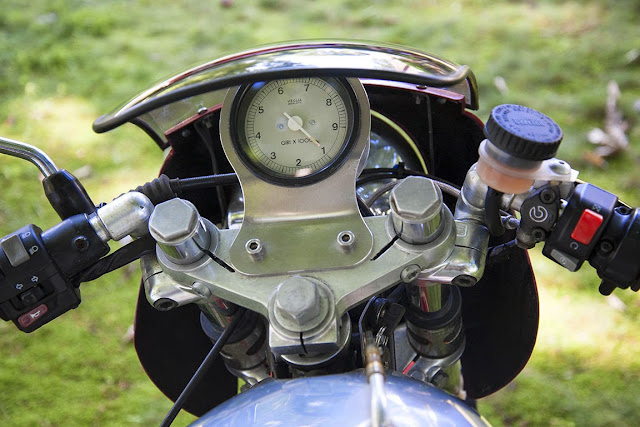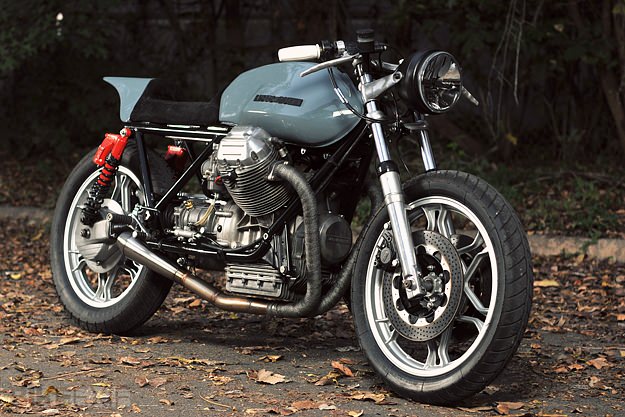Moto Guzzi Le Mans
The Le Mans' lop speed of about 130mph (209km/h) made it one of the fastest bikes on the road in the mid-1970s, and that performance was delivered with a relaxed feel that encouraged fast cruising.
So too did the Guzzi’s excellent high-speed handling, aided by firm and well-damped suspension.
Essentially the Le Mans look was similar to that of previous sporting Guzzis. But the addition of a bikini fairing, plus a new dual seat whose front section covered the rear of the fuel tank, combined with the Italian firm’s trademark engine layout to produce one of the most glamorous and distinctive of superbikes.
Long, lean and unmistakable, with its tiny headlamp fairing and muscular transverse mmmm V-twin engine, the Le Mans was arguably the most stylish superbike of the mid-1970s. Much more than that, it was fast, handled superbly and had excellent brakes. Guzzi's flagship was a hard- charging roadburner that could cruise effortlessly at lOOmph (161km/h), carve through corners at a rapid pace, and generally keep up with the best of its rivals from Italy or Japan.
Moto Guzzi, based on the banks of Lake Como, had a long history of racing success and innovative bikes including the exotic 500cc V8 racer of the 1950s. Although still best known for its long- running singles, Guzzi was having increasing success with its distinctive transverse V-twins. But it was the Le Mans, introduced in 1976. that put the old firm back in the spotlight.
The Le Mans was based on the 750 S3, itself a striking and deceptively rapid unfaired roadster that had been developed from the earlier V7 Sport, Guzzi's first high-performance V-twin. The new bike's most obvious innovation was its striking styling, which combined the headlamp fairing with a curvaceous fuel tank and angular seat.
In search of more power. Guzzi enlarged the S3's 748cc engine to 844cc. and increased compression ratio from 9.8:1 to 10.2:1. They also fitted unfiltered 36mm DelLOrto carburettors plus a new, free-breathing exhaust system. The shaft-drive V-tw'in was still a fairly old-fashioned device with pushrod valve operation and a slow-shifting five- speed gearbox. But it now produced 80bhp at 7300rpm, an increase of 8bhp, and had plenty of mid-range punch, which the smaller S3 motor had rather disappointingly lacked.
That extra power was enough for a top speed of 130mph (209km/h), impressive at the time. The big motor was lumpy at low speed, but smoothed out as the revs rose, and pulled hard through the midrange. Where the Guzzi really scored was with its uniquely long-legged feel which, in combination with the leant-forward riding position and protection from the flyscreen, enabled the Le Mans' rider to keep up those speeds for long periods without discomfort.
Fine handling
A rigid steel frame gave fine handling despite the occasionally unsettling effect of the shaft final drive. The Le Mans wasn’t the lightest or most manoeuvrable of bikes but its high-speed stability was immense, thanks partly to typically stiff suspension. At speeds that would have the riders of rival Japanese superbikes weaving, the Guzzi rumbled on without a twitch, its rider tucked down at the clip-ons behind that neat flyscreen.
Guzzi’s brake set-up of three linked, cast iron Brembo discs was far superior to most rival systems, too, especially in the wet. The handlebar lever operated one front disc; the foot pedal the other plus the rear. By Italian standards the Guzzi was well built and reliable, too, although it suffered from typically poor electrics.
The Le Mans’ high price ensured that it was never going to sell in huge numbers, but it gained a cult following, opened many riders’ eyes to Guzzi’s quirky V-twins, and remained in production for 19 years, through a series of updates. Unfortunately its performance did not improve with age.
On the contrary, the Le Mans Mk2 version of 1979 was slightly slower, though it at least gave its rider the benefit of an angular full fairing. The 1982 model Mk3 regained some power, but Guzzi made things worse in 1985 with the 949cc Le Mans Mk4, whose 16-inch front wheel gave unreliable handling. By this time, the stability and competitive speed of the 1976 model were just a fond memory. In the case of the Moto Guzzi Le Mans, original was definitely best.
Apart from its transverse V-twin motor's protruding cylinders, the Le Mans was a slim and compact hike. Its frame and front forks came from the earlier S3 model. Guzzi s linked braking system used the foot pedal to operate one front disc plus the rear disc, while the other front disc was worked by the handlebar lever.
Specification Moto Guzzi Le Mans 850 (1976)
- Engine Air-cooled ohv four-valve pushrod 90-degree transverse V-twin
- Capacity 844cc (83 x 78mm)
- Maximum power 80bhp @ 7300rpm
- Transmission Five-speed, shaft final drive
- Frame Steel spine
- Suspension Telescopic front; twin shocks rear
- Brakes Twin discs front; single disc rear
- Weight 476lb (216kg) wet
- Top speed 130mph (209km/h)






















0 comments: